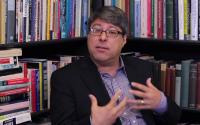5 February 2006The Independent
James Lovelock insists that he's an optimist, but not when it comes to the future of our planet. We have passed the point of no return, says the scientist who invented the concept of the Earth as a planetary "super-organism" and who impishly named it after the ancient Greek goddess Gaia. We have reached a point where civilisation itself is threatened. Life as we know it will never be the same, he warns, and we have no one to blame but our own ignorance and greed.
Lovelock does not normally do pessimism. He has in the past dismissed fears over chemicals in the environment and nuclear power as irrational, and was among those who believed that the Earth is a far more resilient place than eco-warriors imagined. But several things have happened in recent years to change his view. Rather than accommodating human pillage of the environment, the Earth is showing signs of swinging in the opposite direction. Global warming has triggered a vicious cycle of further warming, which is accelerating us towards environmental ruin.
Lovelock's dire warnings of global warming are articulated in his latest book, The Revenge of Gaia. In it he paints a gloomy picture of a future where the polar ice caps have melted, rising seas have inundated the major cities of the world, vast areas of land are reduced to uninhabitable deserts and humanity ekes out a precarious living around a semi-tropical Arctic basin.
"I'm not really saying there is no hope," he insists. "My message is that the lush, comfortable world we are used to is going rapidly and will soon be gone completely. But it doesn't mean the end of everything. It means that civilisation and living things will have to make the most of it in those parts of the world that are still habitable."
This depressing Blade Runner scenario from one of the world's leading green gurus is all the more surprising given his intellectual pedigree. He has been a fellow of the Royal Society since 1974, won a clutch of major science prizes, written hundreds of scientific papers and been voted one of the world's top 100 global thinkers. Not bad for a scientist who is the rarest of academics - a truly independent researcher who gave up his day job 46 years ago when he resigned from the Medical Research Council to go freelance.
"I was 40 at the time and it was a huge decision," he says. "There was no golden handshake. I had four kids and one of them was mentally handicapped and my wife was starting to show symptoms of multiple sclerosis. Of all the times to go independent, it was probably the worst."
Nearly five decades later, at the age of 86, Lovelock's apparent moment of madness has been vindicated. He lives with his second wife, Sandy, in an idyllic old mill on the border of Cornwall and Devon. His study is lined with books and home-made instruments - his most famous invention was a highly sensitive electron-capture detector, which enabled scientists to link the gases in aerosol sprays to the destruction of the ozone hole. (It also made millions of dollars for the manufacturers, Hewlett-Packard, but the patent royalties did not come his way.)
His first big consultancy was in the 1960s with Nasa, which was interested in sending space probes to Mars. "It was working for them on looking for life on Mars that made me realise what a remarkable planet the Earth is," Lovelock recalls. His "eureka" moment came in 1965, when he was in a room with the astronomer Carl Sagan at Nasa's Jet Propulsion Laboratory in California. In walked a colleague clutching an armful of data on the infrared analysis of the atmospheres of Mars and Venus. It was clear that these two planets were in effect dead, with unchanging atmospheres containing little more than carbon dioxide and a few trace gases in a state of static equilibrium. In contrast, the Earth's atmosphere seemed dynamic and alive.
"I began to think - but look at the Earth. What an extraordinary atmosphere, which is so far from equilibrium, yet something is keeping it constant," Lovelock says. "Then it dawned on me, after Carl Sagan made a remark about how the sun was cooler in the past, that perhaps life was helping to keep the Earth constant. So the whole idea of Gaia formed."
He began to think about how life interacts with the non-living, geophysical part of the Earth to make conditions suitable for living organisms. The idea was like the homeostasis of animal physiology, the genetically programmed mechanism for keeping the inner environment of the body constant. The Earth could be likened to a super-organism with its own regulatory feedback mechanisms that ensure the constancy of such things as surface temperature, atmospheric composition and ocean salinity.
Lovelock called this "a cybernetic system with homeostatic tendencies, as detected by chemical anomalies in the Earth's atmosphere". Understandably he wanted a snappier name and his then neighbour, the author William Golding, suggested Gaia, the Earth goddess. Gaia was an instant, if provocative, hit.
Lovelock was not suggesting that Gaia was under some kind of conscious control, or even mysteriously programmed in some way to keep life in balance - which is the case with animal physiology. But that did not stop New Age mystics adopting the idea as scientific proof that "Mother Earth" really was alive and in cosmic harmony, much to Lovelock's chagrin.
Far more serious for him was the criticism of the neo-Darwinists, who could not see how natural selection could possibly bring about a planetary-scale control mechanism that appeared to be designed for life's benefit. The zoologist Richard Dawkins was particularly scathing, dismissing Gaia as bad poetic science.
"There is no way that evolution by natural selection can lead to altruism on a global scale," Dawkins wrote in 1982.
Lovelock admits that he was taken aback by the ferocity of the attacks, although he now seems more sanguine. "Richard's bark is worse than his bite," he says. "I know him quite well and we've always got on reasonably. We behave scientifically like a pair of barristers - slagging each other off to win the case for our clients. I'm very grateful for his criticism."
The problem for the Darwinists is that Gaia invokes the idea of altruism and "group selection", rather than the selfish-gene concept made famous by Dawkins.
In 1995, Lovelock began a dialogue with the Darwinists and collaborated with Bill Hamilton, a man whom Dawkins once described as perhaps the greatest Darwinist since Darwin. But Hamilton was still at a loss to explain how Gaia could have arisen by natural selection.
Gaia has finally come of age. Now the burning issue is whether the age of humans can come to live with Gaia.
LIFE AND TIMES
FAMILY: Born in 1919 in Brixton, London. His mother and father came from modest backgrounds but ran an art gallery in their spare time. Their son, however, preferred the science section of the local library and going on visits to the Science Museum in South Kensington. Lovelock had four children by his first wife. Now lives with his second wife, Sandy, in a converted mill in Cornwall.
EDUCATION: Chemistry degree from Manchester University.
CAREER HIGHLIGHTS: in 1940s and 1950s, worked for the National Institute for Medical Research in Mill Hill, London. His permanent post with the Medical Reseach Council involved working on cryopreservation - freezing and reviving organisms. Developed microwave heater, which he used to warm up his lunch, but failed to patent the idea. In 1959, while on sabbatical at Yale University, Lovelock developed the electron capture detector, which was patented by the US government with patent royalites worth $20m going to the US government. Abandoned paid job to go freelance and was invited to join Nasa in 1961. In 1965, while working with Nasa looking for life on Mars, Lovelock formulated the Earth-systems concept he called Gaia. In 1972 he published a seminal paper on Gaia co-authored with American microbiologist Lynn Margulis. Two years later he was elected to the Royal Society. In 1996 Lovelock won the Volvo Environment Prize and in 1997 the Blue Planet Prize.






